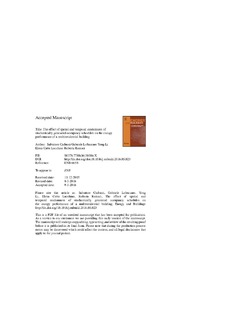| dc.contributor.author | Carlucci, Salvatore | |
| dc.contributor.author | Lobaccaro, Gabriele | |
| dc.contributor.author | Li, Yong | |
| dc.contributor.author | Catto Lucchino, Elena | |
| dc.contributor.author | Ramaci, Roberta | |
| dc.date.accessioned | 2017-11-27T08:25:29Z | |
| dc.date.available | 2017-11-27T08:25:29Z | |
| dc.date.created | 2016-05-10T11:37:34Z | |
| dc.date.issued | 2016 | |
| dc.identifier.citation | Energy and Buildings. 2016, 127 279-300. | nb_NO |
| dc.identifier.issn | 0378-7788 | |
| dc.identifier.uri | http://hdl.handle.net/11250/2468089 | |
| dc.description.abstract | Building performance simulation is frequently used to support building design, renovation, and operation. However, modelers are traditionally concerned with accurately describing technical input data, and have only limited interest in investigating the influence of occupant behavior on buildings’ energy performance. To fill this gap, this article examines the effects of stochastically generated occupancy schedules on the energy performance of a multiresidential high-rise building located in Shanghai, China. The building’s energy performance is analyzed under two design proposals: a law-compliant proposal developed by the designers, and a second proposal conceived through an automatized optimization process. A statistical analysis quantifies the energy implications of adopting different degrees of randomness when creating occupancy and occupancy-dependent schedules. Simulation outcomes show that temporal and spatial randomness of occupancy and occupancy-dependent schedules have a statistically significant influence on the building’s energy performance, with an estimated uncertainty of up to 10%. At least in Shanghai, occupant behavior affects cooling more than heating, and its influence on the energy performance is stronger in high-performance buildings than in poorly insulated ones. Finally, accurate modeling of high-performance buildings would require a detailed and precise description of occupancy and occupant-dependent input variables even if this increases the modeling effort and costs. | nb_NO |
| dc.language.iso | eng | nb_NO |
| dc.publisher | Elsevier | nb_NO |
| dc.rights | Attribution-NonCommercial-NoDerivatives 4.0 Internasjonal | * |
| dc.rights.uri | http://creativecommons.org/licenses/by-nc-nd/4.0/deed.no | * |
| dc.subject | Building ytelse simulering | nb_NO |
| dc.subject | Building performance simulation | nb_NO |
| dc.subject | Beboeratferd | nb_NO |
| dc.subject | Occupant behavior | nb_NO |
| dc.subject | Matematisk optimering | nb_NO |
| dc.subject | Mathematical optimization | nb_NO |
| dc.subject | Energibruk i bygninger | nb_NO |
| dc.subject | Energy use in buildings | nb_NO |
| dc.title | The effect of spatial and temporal randomness of stochastically generated occupancy schedules on the energy performance of a multiresidential building | nb_NO |
| dc.type | Journal article | nb_NO |
| dc.type | Peer reviewed | nb_NO |
| dc.description.version | acceptedVersion | nb_NO |
| dc.subject.nsi | VDP::Arkitektur og bygningsteknologi: 531 | nb_NO |
| dc.subject.nsi | VDP::Architecture and building technology: 531 | nb_NO |
| dc.source.pagenumber | 279-300 | nb_NO |
| dc.source.volume | 127 | nb_NO |
| dc.source.journal | Energy and Buildings | nb_NO |
| dc.identifier.doi | 10.1016/j.enbuild.2016.05.023 | |
| dc.identifier.cristin | 1354756 | |
| dc.relation.project | SiU, Senter for internasjonalisering av utdanning: UTF-2014/10069 | nb_NO |
| dc.description.localcode | © 2016. This is the authors’ accepted and refereed manuscript to the article. LOCKED until 12.5.2018 due to copyright restrictions. This manuscript version is made available under the CC-BY-NC-ND 4.0 license http://creativecommons.org/licenses/by-nc-nd/4.0/ | nb_NO |
| cristin.unitcode | 194,64,35,0 | |
| cristin.unitcode | 194,61,25,0 | |
| cristin.unitname | Institutt for bygg, anlegg og transport | |
| cristin.unitname | Institutt for byggekunst, historie og teknologi | |
| cristin.ispublished | true | |
| cristin.fulltext | original | |
| cristin.qualitycode | 2 | |

